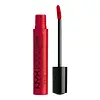NYX Cosmetics Liquid Suede Cream Lipstick Versus NYX Cosmetics Lip Lingerie XXL Long-Lasting Matte Liquid Lipstick
What's inside
What's inside
 Key Ingredients
Key Ingredients

No key ingredients
 Benefits
Benefits

No benefits
 Concerns
Concerns

 Ingredients Side-by-side
Ingredients Side-by-side

Isododecane
EmollientPetrolatum
EmollientTrimethylsiloxysilicate
EmollientCyclopentasiloxane
EmollientPolybutene
Dimethicone
EmollientCopernicia Cerifera Wax
Cyclohexasiloxane
EmollientKaolin
AbrasiveSilica Dimethyl Silylate
EmollientGlyceryl Behenate/Eicosadioate
EmollientPersea Gratissima Oil
Skin ConditioningOlea Europaea Fruit Oil
MaskingPhytosterols
Skin ConditioningTocopherol
AntioxidantGlycerin
HumectantAlumina
AbrasiveCaprylyl Glycol
EmollientPhenoxyethanol
PreservativeMica
Cosmetic ColorantCI 77891
Cosmetic ColorantIron Oxides
CI 42090
Cosmetic ColorantCI 77742
Cosmetic ColorantCI 15850
Cosmetic ColorantCI 45410
Cosmetic ColorantCI 73360
Cosmetic ColorantCI 19140
Cosmetic ColorantCI 77120
Cosmetic ColorantRosin
Isododecane, Petrolatum, Trimethylsiloxysilicate, Cyclopentasiloxane, Polybutene, Dimethicone, Copernicia Cerifera Wax, Cyclohexasiloxane, Kaolin, Silica Dimethyl Silylate, Glyceryl Behenate/Eicosadioate, Persea Gratissima Oil, Olea Europaea Fruit Oil, Phytosterols, Tocopherol, Glycerin, Alumina, Caprylyl Glycol, Phenoxyethanol, Mica, CI 77891, Iron Oxides, CI 42090, CI 77742, CI 15850, CI 45410, CI 73360, CI 19140, CI 77120, Rosin
Dimethicone
EmollientIsododecane
EmollientTrimethylsiloxysilicate
EmollientNylon-611/Dimethicone Copolymer
Skin ConditioningDimethicone Crosspolymer
Emulsion StabilisingC30-45 Alkyldimethylsilyl Polypropylsilsesquioxane
Lauroyl Lysine
Skin ConditioningTriethoxysilylethyl Polydimethylsiloxyethyl Dimethicone
Skin ConditioningSilica Silylate
EmollientIsopropyl Titanium Triisostearate
EmollientSorbic Acid
PreservativePhenoxyethanol
PreservativeParfum
MaskingCI 15850
Cosmetic ColorantCI 45410
Cosmetic ColorantCI 77491
Cosmetic ColorantCI 77492
Cosmetic ColorantCI 77499
Cosmetic ColorantCI 77891
Cosmetic ColorantCI 19140
Cosmetic ColorantCI 42090
Cosmetic ColorantDimethicone, Isododecane, Trimethylsiloxysilicate, Nylon-611/Dimethicone Copolymer, Dimethicone Crosspolymer, C30-45 Alkyldimethylsilyl Polypropylsilsesquioxane, Lauroyl Lysine, Triethoxysilylethyl Polydimethylsiloxyethyl Dimethicone, Silica Silylate, Isopropyl Titanium Triisostearate, Sorbic Acid, Phenoxyethanol, Parfum, CI 15850, CI 45410, CI 77491, CI 77492, CI 77499, CI 77891, CI 19140, CI 42090
Ingredients Explained
These ingredients are found in both products.
Ingredients higher up in an ingredient list are typically present in a larger amount.
Ci 15850 is the pigment color red. It is an azo dye and created synthetically.
Azo dyes need to be thoroughly purified before use. This allows them to be more stable and longer-lasting.
This ingredient is common in foundations, lipsticks, and blushes. This color is described as brown/orangey red.
It has many secondary names such as Red 6 and Red 7. According to a manufacturer, Red 6 usually contains aluminum.
Learn more about CI 15850CI 19140 is also known as Tartrazine. Tartrazine is a synthetic dye used in cosmetics, foods, and medicine to add a yellow color.
Tartrazine is created from petroleum and is water-soluble.
Some people may experience allergies from this dye, especially asthmatics and those with an aspirin intolerance.
Learn more about CI 19140Ci 42090 is a synthetic dye created from petroleum. It is used to give a bright blue color to cosmetics, medicine, and food.
CI 45410 is a synthetic red-pigment and dye.
It often goes by both Red 28 or Red 27; manufacturers label both ingredients as CI 45410.
This dye is commonly found in makeup because it imparts a vivid color. Some types of this dye change color based on pH level and interaction with moisture:
Your skin has a natural pH of around 4.5 - 5.5.
According to the FDA, CI 45410 is not permitted for use in eye products.
Red 27 is a flourescein dye and commonly used as a fluorescent tracer in medicine.
Learn more about CI 45410Ci 77891 is a white pigment from Titanium dioxide. It is naturally found in minerals such as rutile and ilmenite.
It's main function is to add a white color to cosmetics. It can also be mixed with other colors to create different shades.
Ci 77891 is commonly found in sunscreens due to its ability to block UV rays.
Learn more about CI 77891Dimethicone is a type of synthetic silicone created from natural materials such as quartz.
What it does:
Dimethicone comes in different viscosities:
Depending on the viscosity, dimethicone has different properties.
Ingredients lists don't always show which type is used, so we recommend reaching out to the brand if you have questions about the viscosity.
This ingredient is unlikely to cause irritation because it does not get absorbed into skin. However, people with silicone allergies should be careful about using this ingredient.
Note: Dimethicone may contribute to pilling. This is because it is not oil or water soluble, so pilling may occur when layered with products. When mixed with heavy oils in a formula, the outcome is also quite greasy.
Learn more about DimethiconeIsododecane is a fragrance, emollient, and solvent.
As an emollient, it helps your skin stay soft and hydrated. Emollients help trap moisture into your skin.
Isododecane's role as a solvent makes it a great texture enhancer. It spreads smoothly on skin and does not leave a sticky feeling behind. Isododecane also helps prevent color transfer in makeup products.
Isododecane is not absorbed into skin.
Learn more about IsododecanePhenoxyethanol is a preservative that has germicide, antimicrobial, and aromatic properties. Studies show that phenoxyethanol can prevent microbial growth. By itself, it has a scent that is similar to that of a rose.
It's often used in formulations along with Caprylyl Glycol to preserve the shelf life of products.
This silicone is an emollient. Emollients create a thin film on the skin to prevent moisture from escaping.
It is not soluble in water and helps increase water-resistance in products.
According to a manufacturer, it can blend seamlessly with silicone oils, such as Cyclopentasiloxane.
Learn more about Trimethylsiloxysilicate